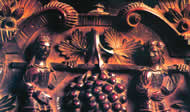Macedonian Art
The Message of the Icon-Painters
By the strokes of the brushes, by the paint employed, even more so by the master's skill with one and the other, you can recognise us and distinguish us one from the other, the leaders of the iconists' guild and the whole clan. In any case, you can decipher our names on the hems of the saints' garments, modestly inscribed. And when the heathen rises above the belfry and whitewash conceals our craft, when such times come, pray for yourselves, oh you, defilers of the scene in front of us! (Michail and Eutychius)
Lence Milosevska
  Fresco-painting. Despite a number of significant achievements, architecture in Macedonia in the early Middle Ages, compared to the accomplishments of Constantinople and Thessaloniki, was largely of provincial character. But fresco-painting in Macedonia in the same period equaled the greatest and most beautiful works of the Byzantine Empire. Fresco-painting. Despite a number of significant achievements, architecture in Macedonia in the early Middle Ages, compared to the accomplishments of Constantinople and Thessaloniki, was largely of provincial character. But fresco-painting in Macedonia in the same period equaled the greatest and most beautiful works of the Byzantine Empire.
Portrait painting was also an important art in the mediaeval period. Among the most famous portraits made on Macedonian soil are the portraits of King Milutin and Simonida in Staro Nagoricane, the portraits of Dusan and Helena at Lesnovo, the group portrait of the Paskaca family at Psaca, and the portraits of Volkasin and his son Marko in the church of St. Archangel in Varos and in Marko's monastery. In view of the popularity of portraits in Byzantium, it would be logical that portraits had long been included in Macedonian churches but no portraits have been preserved from the period prior to the 13th century.
  Icon painting. After several visits by the Apostle Peter to Thessaloniki, Christianity began to quickly spread throughout Macedonia. Confirmation of this are a number of early Christian basilicas in Macedonia, including a hundred or so square meters of excellently preserved floor mosaics abounding in iconography and showing a high level of technical expertise, remnants of stone sculptures and 50 recently unearthed icons in ruins near the small town of Vinica. These icons are all made of terracotta, and hence called terracotta icons. Icon painting. After several visits by the Apostle Peter to Thessaloniki, Christianity began to quickly spread throughout Macedonia. Confirmation of this are a number of early Christian basilicas in Macedonia, including a hundred or so square meters of excellently preserved floor mosaics abounding in iconography and showing a high level of technical expertise, remnants of stone sculptures and 50 recently unearthed icons in ruins near the small town of Vinica. These icons are all made of terracotta, and hence called terracotta icons.
read more...
  Wood carving. It is normal to suppose that decorative sculpture was complementary to fresco-painting and an integral part of the architectural arrangements and the architectural conception. The oldest specimens of decorative sculpture in Macedonia are the wood carvings on the altar screen in the church of St. Sophia in Ohrid. After the Ottoman conquest, the influence of Middle Eastern elements in the Macedonian wood carving became much stronger. The shallow and flat arabesque style of carving dominating until the 17th century began to be replaced by more intricate styles of carving. In the monasteries of Slepce, Treskavec, Zrze, Varos (near Prilep), and in the Monastery of the Holy Immaculate Virgin of Kicevo, a number of works by Macedonian wood-carvers have been preserved. They reveal the characteristics of the Slepce-Prilep wood-carver's school: shallow and flat carving and rich geometrically interwoven floral and animal motifs. Wood carving. It is normal to suppose that decorative sculpture was complementary to fresco-painting and an integral part of the architectural arrangements and the architectural conception. The oldest specimens of decorative sculpture in Macedonia are the wood carvings on the altar screen in the church of St. Sophia in Ohrid. After the Ottoman conquest, the influence of Middle Eastern elements in the Macedonian wood carving became much stronger. The shallow and flat arabesque style of carving dominating until the 17th century began to be replaced by more intricate styles of carving. In the monasteries of Slepce, Treskavec, Zrze, Varos (near Prilep), and in the Monastery of the Holy Immaculate Virgin of Kicevo, a number of works by Macedonian wood-carvers have been preserved. They reveal the characteristics of the Slepce-Prilep wood-carver's school: shallow and flat carving and rich geometrically interwoven floral and animal motifs.
|